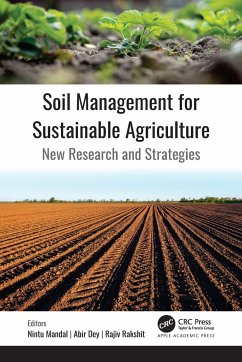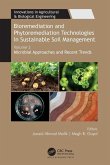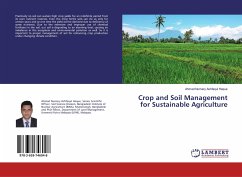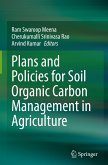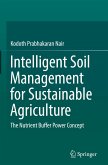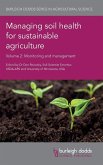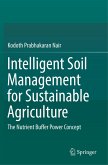Soil Management for Sustainable Agriculture
New Research and Strategies
Herausgeber: Mandal, Nintu; Rakshit, Rajiv; Dey, Abir
Soil Management for Sustainable Agriculture
New Research and Strategies
Herausgeber: Mandal, Nintu; Rakshit, Rajiv; Dey, Abir
- Gebundenes Buch
- Merkliste
- Auf die Merkliste
- Bewerten Bewerten
- Teilen
- Produkt teilen
- Produkterinnerung
- Produkterinnerung
This book explores the various soil management techniques and the latest improvements in soil management. Taking a sustainable approach, the volume begins with an overview of the elementary concepts of soil management and then delves into new research and novel soil management tools and techniques
Andere Kunden interessierten sich auch für
![Bioremediation and Phytoremediation Technologies in Sustainable Soil Management Bioremediation and Phytoremediation Technologies in Sustainable Soil Management]() Bioremediation and Phytoremediation Technologies in Sustainable Soil Management132,99 €
Bioremediation and Phytoremediation Technologies in Sustainable Soil Management132,99 €![Sustainable Soil Management Sustainable Soil Management]() Sustainable Soil Management170,99 €
Sustainable Soil Management170,99 €![Crop and Soil Management for Sustainable Agriculture Crop and Soil Management for Sustainable Agriculture]() Ahmad Numery Ashfaqul HaqueCrop and Soil Management for Sustainable Agriculture26,99 €
Ahmad Numery Ashfaqul HaqueCrop and Soil Management for Sustainable Agriculture26,99 €![Plans and Policies for Soil Organic Carbon Management in Agriculture Plans and Policies for Soil Organic Carbon Management in Agriculture]() Plans and Policies for Soil Organic Carbon Management in Agriculture161,99 €
Plans and Policies for Soil Organic Carbon Management in Agriculture161,99 €![Intelligent Soil Management for Sustainable Agriculture Intelligent Soil Management for Sustainable Agriculture]() Kodoth Prabhakaran NairIntelligent Soil Management for Sustainable Agriculture112,99 €
Kodoth Prabhakaran NairIntelligent Soil Management for Sustainable Agriculture112,99 €![Managing soil health for sustainable agriculture Volume 2 Managing soil health for sustainable agriculture Volume 2]() Managing soil health for sustainable agriculture Volume 2299,99 €
Managing soil health for sustainable agriculture Volume 2299,99 €![Intelligent Soil Management for Sustainable Agriculture Intelligent Soil Management for Sustainable Agriculture]() Kodoth Prabhakaran NairIntelligent Soil Management for Sustainable Agriculture82,99 €
Kodoth Prabhakaran NairIntelligent Soil Management for Sustainable Agriculture82,99 €-
-
-
This book explores the various soil management techniques and the latest improvements in soil management. Taking a sustainable approach, the volume begins with an overview of the elementary concepts of soil management and then delves into new research and novel soil management tools and techniques
Hinweis: Dieser Artikel kann nur an eine deutsche Lieferadresse ausgeliefert werden.
Hinweis: Dieser Artikel kann nur an eine deutsche Lieferadresse ausgeliefert werden.
Produktdetails
- Produktdetails
- Verlag: Apple Academic Press
- Seitenzahl: 626
- Erscheinungstermin: 8. Februar 2021
- Englisch
- Abmessung: 240mm x 161mm x 38mm
- Gewicht: 1095g
- ISBN-13: 9781774630235
- ISBN-10: 1774630230
- Artikelnr.: 62797932
- Herstellerkennzeichnung
- Libri GmbH
- Europaallee 1
- 36244 Bad Hersfeld
- gpsr@libri.de
- Verlag: Apple Academic Press
- Seitenzahl: 626
- Erscheinungstermin: 8. Februar 2021
- Englisch
- Abmessung: 240mm x 161mm x 38mm
- Gewicht: 1095g
- ISBN-13: 9781774630235
- ISBN-10: 1774630230
- Artikelnr.: 62797932
- Herstellerkennzeichnung
- Libri GmbH
- Europaallee 1
- 36244 Bad Hersfeld
- gpsr@libri.de
Nintu Mandal, PhD, is Assistant Professor-cum-Junior Scientist in the Department of Soil Science and Agricultural Chemistry, Bihar Agricultural University, India. He has published 20 research/review papers in national and international journals and has authored one book, Agricultural Nanotechnology: Basics and Practicals. He has also co-authored several book chapters. He holds a patent for "A Superabsorbent Polymer (NSP) and Process for Preparing the Same." His current research areas are nanoformulations for increasing input use efficiency, soil chemistry, and clay mineralogy. Abir Dey, PhD, is Agricultural Research Scientist in the Division of Soil Science and Agricultural Chemistry, ICAR-IARI, New Delhi, India. He has published 19 research/review papers in national and international journals. He has also co-authored one book and several book chapters. His current research areas are conservation agriculture, soil carbon dynamics, quality of soil organic matter, soil fertility, and plant nutrition. Rajiv Rakshit, PhD, is Assistant Professor-cum-Junior Scientist in the Department of Soil Science and Agricultural Chemistry, Bihar Agricultural University, India. He has published 25 research/review papers in national and international journals and has co-authored five book chapters. He has also reviewed many research papers for internationally reputed journals. His research interests are focused on soil quality, soil microbial interactions, soil carbon, and nutrient dynamics. His aim is to improve the understanding of how fertilization affects nutrient cycling and microbial interactions in soils.
PART 1: CLAYS: THE CRITICAL COMPONENT IN SUSTAINABLE AGRICULTURE WITH
RESPECT TO CARBON SEQUESTRATION VIS-A-VIS THEIR INTERACTION WITH SOIL
ENZYMES 1. Advances in Clay Research for Sustainable Agriculture 2.
Clay-Enzyme Interactions and Implications 3. Short Range Order (SRO)
Minerals and Implications in Sustainable Agriculture PART 2: POTENTIAL
UTILIZATION OF MICROBES FOR STRESSED AGRICULTURE 4. Rhizospheric Microbes
for Nutrient Fortification in Crop Plants 5. Managing Abiotic Stressed
Agriculture through Microbes 6. An Overview of Biochar Application on
Biological Soil Health Indicators and Greenhouse Gas Emission PART 3:
RESOURCE CONSERVATION TECHNOLOGIES AND PROSPECTIVE CARBON MANAGEMENT
STRATEGIES 7. Resource Conservation Technologies for Sustainable Soil
Management 8. Soil Organic Carbon, Its Retention, and Implication for
Sustainable Agriculture 9. Hydrothermal Sensitivity of Soil Organic Carbon
Under Imminent Moisture and Temperature Stress PART 4: SMART TOOLS FOR
MONITORING SOILS 10. Application of Remote Sensing Technology for
Estimation of Soil Moisture 11. Spectral and Smartphone-Based Tools to
Monitor Plant and Soil Nitrogen Status for Site-Specific Nitrogen
Management in Crop Plants 12. Innovative Extension Approaches for Diffusion
of Nutrient Management Technologies PART 5: NUTRIENT MANAGEMENT APPROACHES
13. The Panorama of Phosphorus Fertilization in Crop Production 14. Novel
Potassium Management Strategies for Improvement of Soil Health 15.
Micronutrient Management in Soils and the Route to Biofortification PART 6:
NANOTECHNOLOGICAL INTERVENTIONS 16. Escalating Nutrient Use Efficiency
through Nanotechnological Intercessions 17. Hydrogel Formulations for
Increasing Input Use Efficiency in Agriculture 18. Nanotechnological
Interventions for Increasing Nutrient Use Efficiency in Horticultural Crops
19. Advances in Micronutrient Fertilizer Production and Its Efficacy in
Plant Nutrition PART 7: REMEDIATION OF METALS AND PESTICIDES CONTAMINATED
SOILS 20. Heavy Metal Pollution in Soil and Remediation Strategies 21.
Advancement in Pesticide Chemistry for Sustainable Agriculture 22. Resource
Recovery from Biowaste for Agriculture through Composting and Microbial
Technology
RESPECT TO CARBON SEQUESTRATION VIS-A-VIS THEIR INTERACTION WITH SOIL
ENZYMES 1. Advances in Clay Research for Sustainable Agriculture 2.
Clay-Enzyme Interactions and Implications 3. Short Range Order (SRO)
Minerals and Implications in Sustainable Agriculture PART 2: POTENTIAL
UTILIZATION OF MICROBES FOR STRESSED AGRICULTURE 4. Rhizospheric Microbes
for Nutrient Fortification in Crop Plants 5. Managing Abiotic Stressed
Agriculture through Microbes 6. An Overview of Biochar Application on
Biological Soil Health Indicators and Greenhouse Gas Emission PART 3:
RESOURCE CONSERVATION TECHNOLOGIES AND PROSPECTIVE CARBON MANAGEMENT
STRATEGIES 7. Resource Conservation Technologies for Sustainable Soil
Management 8. Soil Organic Carbon, Its Retention, and Implication for
Sustainable Agriculture 9. Hydrothermal Sensitivity of Soil Organic Carbon
Under Imminent Moisture and Temperature Stress PART 4: SMART TOOLS FOR
MONITORING SOILS 10. Application of Remote Sensing Technology for
Estimation of Soil Moisture 11. Spectral and Smartphone-Based Tools to
Monitor Plant and Soil Nitrogen Status for Site-Specific Nitrogen
Management in Crop Plants 12. Innovative Extension Approaches for Diffusion
of Nutrient Management Technologies PART 5: NUTRIENT MANAGEMENT APPROACHES
13. The Panorama of Phosphorus Fertilization in Crop Production 14. Novel
Potassium Management Strategies for Improvement of Soil Health 15.
Micronutrient Management in Soils and the Route to Biofortification PART 6:
NANOTECHNOLOGICAL INTERVENTIONS 16. Escalating Nutrient Use Efficiency
through Nanotechnological Intercessions 17. Hydrogel Formulations for
Increasing Input Use Efficiency in Agriculture 18. Nanotechnological
Interventions for Increasing Nutrient Use Efficiency in Horticultural Crops
19. Advances in Micronutrient Fertilizer Production and Its Efficacy in
Plant Nutrition PART 7: REMEDIATION OF METALS AND PESTICIDES CONTAMINATED
SOILS 20. Heavy Metal Pollution in Soil and Remediation Strategies 21.
Advancement in Pesticide Chemistry for Sustainable Agriculture 22. Resource
Recovery from Biowaste for Agriculture through Composting and Microbial
Technology
PART 1: CLAYS: THE CRITICAL COMPONENT IN SUSTAINABLE AGRICULTURE WITH
RESPECT TO CARBON SEQUESTRATION VIS-A-VIS THEIR INTERACTION WITH SOIL
ENZYMES 1. Advances in Clay Research for Sustainable Agriculture 2.
Clay-Enzyme Interactions and Implications 3. Short Range Order (SRO)
Minerals and Implications in Sustainable Agriculture PART 2: POTENTIAL
UTILIZATION OF MICROBES FOR STRESSED AGRICULTURE 4. Rhizospheric Microbes
for Nutrient Fortification in Crop Plants 5. Managing Abiotic Stressed
Agriculture through Microbes 6. An Overview of Biochar Application on
Biological Soil Health Indicators and Greenhouse Gas Emission PART 3:
RESOURCE CONSERVATION TECHNOLOGIES AND PROSPECTIVE CARBON MANAGEMENT
STRATEGIES 7. Resource Conservation Technologies for Sustainable Soil
Management 8. Soil Organic Carbon, Its Retention, and Implication for
Sustainable Agriculture 9. Hydrothermal Sensitivity of Soil Organic Carbon
Under Imminent Moisture and Temperature Stress PART 4: SMART TOOLS FOR
MONITORING SOILS 10. Application of Remote Sensing Technology for
Estimation of Soil Moisture 11. Spectral and Smartphone-Based Tools to
Monitor Plant and Soil Nitrogen Status for Site-Specific Nitrogen
Management in Crop Plants 12. Innovative Extension Approaches for Diffusion
of Nutrient Management Technologies PART 5: NUTRIENT MANAGEMENT APPROACHES
13. The Panorama of Phosphorus Fertilization in Crop Production 14. Novel
Potassium Management Strategies for Improvement of Soil Health 15.
Micronutrient Management in Soils and the Route to Biofortification PART 6:
NANOTECHNOLOGICAL INTERVENTIONS 16. Escalating Nutrient Use Efficiency
through Nanotechnological Intercessions 17. Hydrogel Formulations for
Increasing Input Use Efficiency in Agriculture 18. Nanotechnological
Interventions for Increasing Nutrient Use Efficiency in Horticultural Crops
19. Advances in Micronutrient Fertilizer Production and Its Efficacy in
Plant Nutrition PART 7: REMEDIATION OF METALS AND PESTICIDES CONTAMINATED
SOILS 20. Heavy Metal Pollution in Soil and Remediation Strategies 21.
Advancement in Pesticide Chemistry for Sustainable Agriculture 22. Resource
Recovery from Biowaste for Agriculture through Composting and Microbial
Technology
RESPECT TO CARBON SEQUESTRATION VIS-A-VIS THEIR INTERACTION WITH SOIL
ENZYMES 1. Advances in Clay Research for Sustainable Agriculture 2.
Clay-Enzyme Interactions and Implications 3. Short Range Order (SRO)
Minerals and Implications in Sustainable Agriculture PART 2: POTENTIAL
UTILIZATION OF MICROBES FOR STRESSED AGRICULTURE 4. Rhizospheric Microbes
for Nutrient Fortification in Crop Plants 5. Managing Abiotic Stressed
Agriculture through Microbes 6. An Overview of Biochar Application on
Biological Soil Health Indicators and Greenhouse Gas Emission PART 3:
RESOURCE CONSERVATION TECHNOLOGIES AND PROSPECTIVE CARBON MANAGEMENT
STRATEGIES 7. Resource Conservation Technologies for Sustainable Soil
Management 8. Soil Organic Carbon, Its Retention, and Implication for
Sustainable Agriculture 9. Hydrothermal Sensitivity of Soil Organic Carbon
Under Imminent Moisture and Temperature Stress PART 4: SMART TOOLS FOR
MONITORING SOILS 10. Application of Remote Sensing Technology for
Estimation of Soil Moisture 11. Spectral and Smartphone-Based Tools to
Monitor Plant and Soil Nitrogen Status for Site-Specific Nitrogen
Management in Crop Plants 12. Innovative Extension Approaches for Diffusion
of Nutrient Management Technologies PART 5: NUTRIENT MANAGEMENT APPROACHES
13. The Panorama of Phosphorus Fertilization in Crop Production 14. Novel
Potassium Management Strategies for Improvement of Soil Health 15.
Micronutrient Management in Soils and the Route to Biofortification PART 6:
NANOTECHNOLOGICAL INTERVENTIONS 16. Escalating Nutrient Use Efficiency
through Nanotechnological Intercessions 17. Hydrogel Formulations for
Increasing Input Use Efficiency in Agriculture 18. Nanotechnological
Interventions for Increasing Nutrient Use Efficiency in Horticultural Crops
19. Advances in Micronutrient Fertilizer Production and Its Efficacy in
Plant Nutrition PART 7: REMEDIATION OF METALS AND PESTICIDES CONTAMINATED
SOILS 20. Heavy Metal Pollution in Soil and Remediation Strategies 21.
Advancement in Pesticide Chemistry for Sustainable Agriculture 22. Resource
Recovery from Biowaste for Agriculture through Composting and Microbial
Technology

